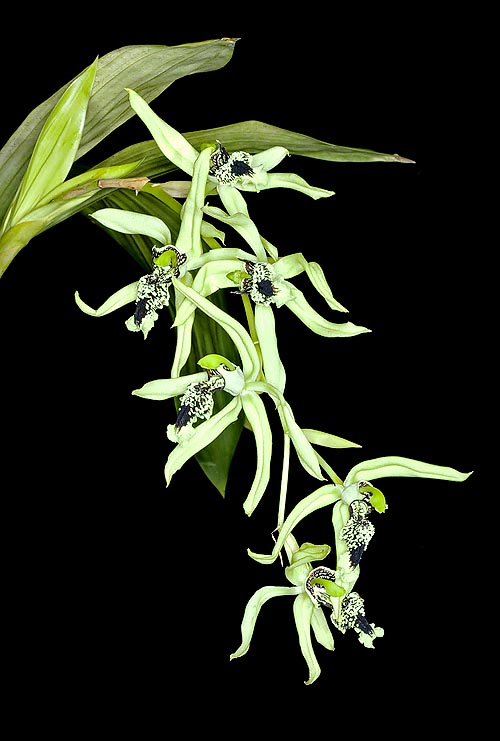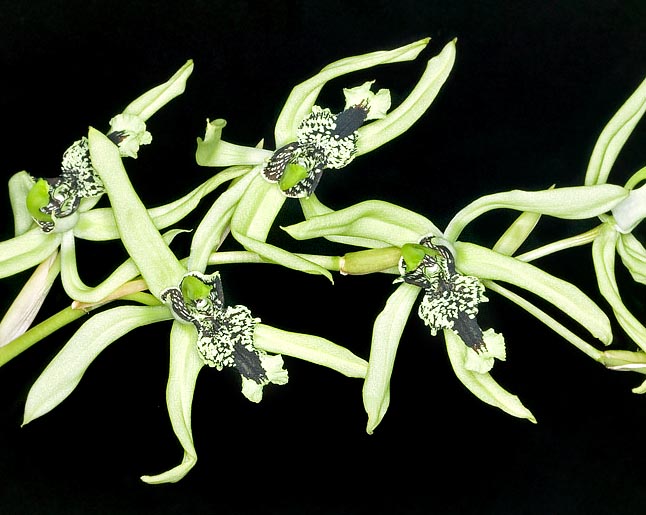Family : Orchidaceae

Text © Pietro Puccio

English translation by Mario Beltramini

The Coelogyne pandurata has 15-40 cm hanging inflorescences © Giuseppe Mazza
The name of the genus is the combination of the Greek term “koilos” = hollow and “gyne” = female, with reference to the hollow stigma.
The name of the species comes from the Greek “pandura”, a string instrument similar to the lute, with reference to the labellum, shaped like a violin.
Common names: black orchid (English); orchidée noire (French); orchidea nera (Italian); Schwarze Orchidee (German).
The Coelogyne pandurata Lindl. (1853) is an herbaceous species with creeping rhizome from which depart, spaced of 5-10 cm, robust oblong pseudobulbs, rather flattened, 7-14 cm long, with at the apex two rigid leaves, plicate, of an elliptic-lanceolate shape, 20-50 cm long and 7 cm broad, on a robust petiole.
The inflorescences, produced in spring-summer at the centre of the emerging vegetation, are arcuate, 15-40 cm long, carrying 6 to 15 flowers pleasantly perfumed and long-lasting, about two weeks, of 6-10 cm of diameter, of pale emerald green colour, with whitish warts and blackish venations and spots on the labellum.
Linear sepals, 3-5 cm long and 1,2 cm broad, the dorsal being slightly broader than the lateral ones, oblong petals, 4-5 cm long and 1,2 cm broad, with pointed apex, and tri-lobed labellum, panduriform, about 4 cm long and 1,5 cm broad, with lateral curved lobes and central lobe with crimped and undulated edges, 1,5-2,5 cm long pale green column.
The fruits are ellipsoid capsules of 6-8 cm of length and 4-6 cm of diameter.
It reproduces by seed, in vitro, and by division, with each section provided with 3-4 pseudobulbs.
It is a famous species due to the almost black spots on the labellum; it requires a humid warm climate with temperatures of 22-32 °C in summer, humidity 70-90%, and partial shade, slightly lower temperatures in winter, 16-26 °C, maximum luminosity, but not in direct sun and humidity 60-80%; a good circulation of air is essential in all the seasons.

The pale emerald green with black patterns and warts flowers are long-lasting and perfumed © Giuseppe Mazza
The waterings must be regular in summer, letting to dry partially before giving water again, slightly more spaced in winter, but without never allowing the compost to dry up completely; the water stagnations between the leaves of the emerging vegetation are to be avoided.
For the watering and the nebulisations, rainwater, water obtained by reverse osmosis or demineralised are to be utilized; the fertilizations, duly distri- buted in way to avoid salts accumulation, are to be done during the vegetative period, preferably with hydrosoluble balanced products, with microelements, at half, or less, dosage than what suggested on the package.
It is cultivable in pots or in low and rather wide baskets, seen the quite cumbersome size of the plant, with draining and well aerated compost which may be formed by a mix of medium-sized bark, sphagnum, coir and fragments of charcoal.
Division and repotting are to be done as soon as the new roots at the base of the pseudobulb do appear once this one has completed the flowering.
The species is inscribed into the appendix II of the CITES (species whose trade is internationally ruled).
Synonyms: Pleione pandurata (Lindl.) Kuntze (1891); Coelogyne peltastes var. unguiculata J.J.Sm. (1927).
→ For general notions about ORCHIDACEAE please click here.
